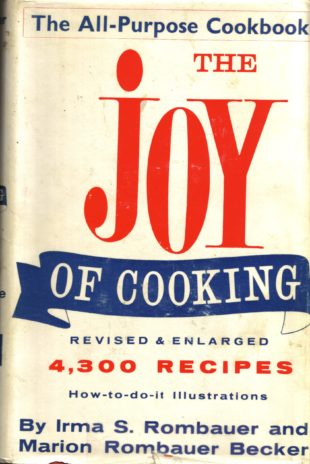Joy of Cooking: Introduction
Joy of Cooking by Irma S. Rombauer was first published by Irma Rombauer in 1931. It soon became the cookbook of choice throughout the United States.
It is somewhat derivative of Mrs Beeton’s Book of Household Management in that it is not just a recipe book but also delves into issues of household etiquette and entertainment.
Irma Rombauer (1877 – 1962) was both the initial author and publisher of the book with the first edition being published in 1931 by A.C. Clayton, a company from St Louis in Missouri that had never printed a book before!
However it was a success with Joy of Cooking selling out within a year. The book went through many editions, with the copies being printed during the war in the 1940s slanted towards recipes that could take advantage of the restricted rations during that time.
Later versions of the book were supervised by her daughter and then later her grandson.
You can read more about the author and the various editions of the book on Wikipedia:
Joy of Cooking: The Book
The cover promises 4500 recipes and it is true that the book is very dense with recipes throughout with 2 columns of recipes per page and with each recipe
When we arrive at the Canapes and Tea Sandwiches chapter there is a lot to be avoided such as Cream Cheese Spreads or Pizza Canapes based on English Muffins! And when we read the salad of canned pineapple topped with ‘riced’ cream cheese, then the shutters really go up!
However it is not all bad. There are some recipes that we can all learn from if the bad examples are ignored.
For example, when you turn to the chapter on fruits there is some erudite, useful writing. You will find discussions on exotic fruits (for the time) such as pomegranates, sapodillas, tamarind and pawpaw.
There is even some recipes that were ahead of the pack such as one for cooking a whole lamb’s head and another to make head cheese from a calves head where the reader is urged to clean the teeth and remove the ears, brains, eyes and snout.
With all these extras removed it is also good to know that there are recipes for brain fritters, jellied feet, liver, lungs and sweetbreads (but not the ears)!

It is interesting to note that in the discussion of fish they talk about various uses of roe and even discuss milt which is the sperm of the male fish, but do not provide a method of cooking it.
In case you are interested the photo below shows a dish of sea bass milt as it was served at an excellent restaurant called Sushi-Ya. The Japanese name for this dish is “shirako”.
The section of soups is good with ‘real’ recipes in many cases including those for gumbo, borsch, split pea soup, oxtail soup and even mulligatawny.
When you get to the section on jellies there is much here that can be immediately translated into the modern era. The only difference might be that leaf gelatine is now widely available and is a much better product to work with than powdered gelatine.
As an example, look at the recipe for Black Raspberry and Gooseberry Jelly. This is a great recipe for creating a jelly from pure fruit.
We then looked at the pickles section and saw the recipe for pickled watermelon rind. This reminded us of a trendy restaurant (Indigo in Bayou Rd) we had visited on a number of occasions in New Orleans. They produced simply the best pickles (including the watermelon variety).
You can’t help the feeling that the recipes have been gradually adapted to modern American lifestyle choices as the editions have progressed. There is more ketchup, more Italian paste, more canned products including the insidious canned pineapple.
The Joy of Cooking is an historically important book that provides a snapshot of cooking in the 1930s, however we can’t help feeling that the ‘improvements and updates’ made to the book since then have diminished its usefulness.
We think that this book deserves a place in the Foodtourist Top Fifty Cookbooks due to the impact it has had in the United States.
You can buy Joy of Cooking by clicking on the link below. We receive a small percentage of the sale which goes towards maintaining this site.






















